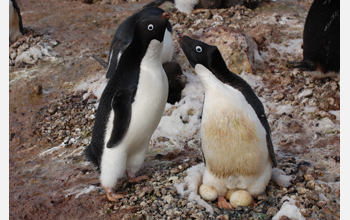Multimedia Gallery
Penguin Science.com (Image 11)
An Adelie penguin couple changes places on their nest at Cape Royds on Ross Island, Antarctica. The outgoing penguin will journey many miles to the ocean for food, and in some years this can be a very long distance. If a parent must make a long journey for food at the beginning of the season, they may not get back in time to feed the newly hatched chick. As the season progresses, the sea ice breaks up bringing the open ocean closer and trips for food shorter.
Jean Pennycook, who has a background in education and is currently an Einstein Fellow at the National Science Foundation, observes and tracks Adelie penguin families at Cape Royds for her outreach project that she posts on the website penguinscience.com. Ross Island is a giant living laboratory where thousands of Adelie penguins converge in raucous crowds during Antarctica's warmer months to breed and rear their young.
Pennycook, who works on an Adelie penguin research team led by David Ainley, an ecologist with H.T. Harvey & Associates, brings the science and research of penguins and the adventure and beauty of Antarctica to classrooms around the world. She makes the science accessible to people of all ages through an interactive webpage, daily pictures from the field and classroom activities for teachers to engage their students in the lives of these remarkable birds.
Ainley's team is researching how penguins are coping with a rapidly changing climate and changes caused by commercial fishing. The team monitors the birds with an array of high tech equipment including computerized weigh bridges, satellite telemetry and microchips to identify individual penguins. With these tools the team is examining how penguin resources (prey and habitat), competition (among themselves and with other species such as whales) and climate factors (wind and sea ice conditions) are affecting their populations. In addition to advanced technology, 55 years of long-term research conducted at these colonies has made the Adelie penguin one of the world's best-studied wild birds, and, lately, a harbinger of environmental change.
Ainley's research is funded by the National Science Foundation. (Date of Image: unknown) [Image 11 of 24 related images. See Image 12.]
Credit: penguinscience.com
Images and other media in the National Science Foundation Multimedia Gallery are available for use in print and electronic material by NSF employees, members of the media, university staff, teachers and the general public. All media in the gallery are intended for personal, educational and nonprofit/non-commercial use only.
Images credited to the National Science Foundation, a federal agency, are in the public domain. The images were created by employees of the United States Government as part of their official duties or prepared by contractors as "works for hire" for NSF. You may freely use NSF-credited images and, at your discretion, credit NSF with a "Courtesy: National Science Foundation" notation.
Additional information about general usage can be found in Conditions.
Also Available:
Download the high-resolution JPG version of the image. (3.2 MB)
Use your mouse to right-click (Mac users may need to Ctrl-click) the link above and choose the option that will save the file or target to your computer.



